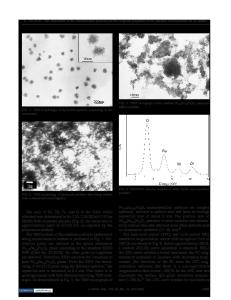Transmission Electron Microscope Observation of Dislocations in Ordered Intermetallic Alloys and the Flow Stress Anomaly
- PDF / 2,723,090 Bytes
- 14 Pages / 420.48 x 639 pts Page_size
- 86 Downloads / 450 Views
TRANSMISSION ELECTRON MICROSCOPE OBSERVATION OF DISLOCATIONS IN ORDERED INTERMETALLIC ALLOYS AND THE FLOW STRESS ANOMALY PATRICK VEYSSI]ERE Laboratoire d'Etude des Microstructures (UMR 55), CNRS-ONERA, BP 72, 92322 Chatillon Cedex, France. ABSTRACT It is only within the last five years that, with the increasing interest of several specialized groups, the amountof accurate TEM information on dislocations in ordered alloys, and in particular in theLl 2 structure, has become significant. Our knowledge on superdislocation cores related todeformation under various temperature and deformation modes, is now sufficiently documented in order to be critically reviewed and this is the object of the present contribution. INTRODUCTION Considering the amount of work so far devoted to the so-called flow stress anomaly of ordered alloys, relatively little has been done on the direct observation of dislocations by transmission electron microscopy (TEM) and on the detailed study of their t-ne structure. In particular, although the weak-beam (WB) dark-field technique, introduced about 20 years ago ', was readily shown to have great applicability to ordered materials 2 , very few weak-beam analyses dedicated to dissociation in this category of alloys were then published until the late 70s 3-. During about the same period of time, the models to explain the positive dependence of flow stress upon temperature were being refineds-l° after it had been acknowledged that the flow stress anomaly originates from properties that are intrinsic to dislocation cores. The present article contains three parts. In the first part, experimental procedures involved in TEM investigations are examined and their incidence on microstructural analysis are critically detailed. The second partcon stitutes the body of this review and deals with thecontribution of TEM to the understanding of the flow stress anomaly in ordered alloys. In the last part, several points as for instance the nature of high temperature configurations are addressed. The choice of examples made in the following reflects no more than the fact that, within ordered intermetallic alloys, crystals with the L12 structure--and especially Ni3Al-based alloys--are the most investigated ones. HOW WELL DO THIN FOILS REPRESENT MICROSTRUCTURES IN THE BULK ? Rather than the chances to succeed in obtaining a comprehensive view of the bulk microstructure from a limited fraction of a deformation sample (10-6 at most1 1 ), the questions which will be raised in this section are concerned with the changes the dislocation microstructure is subjected to during preparation and study of TEM samples. This aspect is generally disregarded and appropriate information very seldom given on experimental procedures. It is the aim of this part to show on the one hand that whatever the TEM technique employed, the chances to face an artefact are not negligible and on the other hand that this does not however preclude TEM analyses or deformation microstructures.
The influence of foil thickness : static experiments TEM anal
Data Loading...











